Best Star Trek inventions that came true
Mon, 29 Oct 2012
Communicators, Universal Translators and Telepresence, three of the best Star Trek Technologies that actually came true.
Amazingly, what seemed like gadgets of the distant future only 25 years ago, now exist in reality. Like the Bluetooth hands-free device and mobile phones pictured below alongside the Communicators first worn or held by Captain Scott and his team.

Blue-tooth and Star Trek lapel Communicator, iPhone and hand-held Communicator side-by-side
Other familiar inventions include online translation tools now capable of translating voice to voice, known to Star Trek aficionados as the Universal Translator which appeared way back in the first 1967 series but was best put to use by Ensign Hoshi Sato in the 2001 ‘Star Trek: Enterprise’ series, allowing cultures from different worlds to communicate. iPhone apps are available for download.
Telepresence is an increasingly common and useful business communication tool in which a room is suitably camered and microphoned to be able to reproduce a realistic image and sound environment which feels like “everyone is in the same room” and allows clear observation of body language and facial expressions. The ConnetU London Docklands data centre has this facility, which looks remarkably like the Enterprise Bridge, without the Klingons, or in this case, Abraham Lincoln (The Savage Curtain):
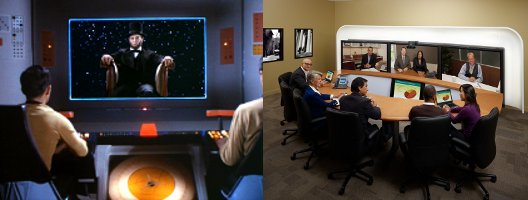
Telepresence rooms, then and now
Back in the physical world, phasers can indeed be set to stun with Laser Guided Energy and Laser Induced Plasma Energy technologies from Applied Energetics. High-voltage bursts or pulses of energy are transmitted to a target with the intention to stun whilst reducing collateral damage. Indeed, a recent experiment conducted by Boeing in the Western Utah desert claims to have taken out electronic systems in whole office buildings by launching a drone with the capability of targeting using a debilitating microwave blast:
Hypospray, as seen on the medical bay in Star Trek, used to inject fluids and medicine into the body, resembles a very real technique for mass inoculation using the Jet Injector Gun or Ped-O-Jet.
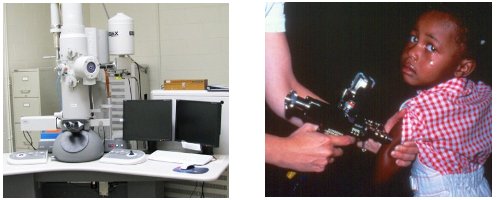
Left: Tractor beam for nano particles at the National University of Singapore. Right: ‘Hypospray like’ device in use.
Other inventions are less well known: tractor beams, as seen in many a Star Trek episode where one, usually larger, space ship holds the other in its grasp simply by projecting as beam of energy, are yet to be realised. This closest we have are a pair of optical tweezers that use lasers for manipulation at a molecular level. The equipment seen here (above left) is shown in use in this video:
In Star Trek we have always had the hand-held Tricorder, used for scientifically analysing environments. Today’s real-word hand-held analysis gizmos really are out of this world: they consist of NASA’s LOCAD-PTS device, which can sense bugs such as E. coli, fungi and salmonella on-board the International Space Station. Beyond that there are two hand-held medical devices for use on planet Earth: Loughborough University’s heart monitor device that uses photoplethysmography technology and Harvard Medical School’s device for non-invasive inspection of the body that uses similar tech to MRI; the latter is said to be 800 times more sensitive than current equipment and is set to revolutionise diagnosis.
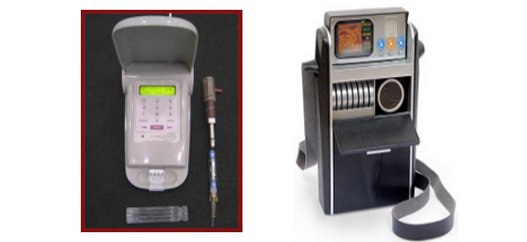
NASA’s Lab-On-a-Chip Application Development–Portable Test System vs Spock’s Tricorder (early version)
The one invention we don’t yet have and probably would happily swap all these inventions for is the transporter, or “energy matter scrambler”. Yet all is not lost: an experiment carried out by scientists funded by the Euproean Space Agency has used the recondite science of quantum entanglement to “teleport” the state of matter rather than matter itself.
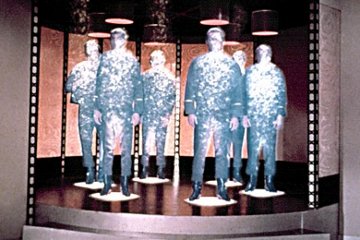
Star Trek Transporter (early version)
Tiny packets of light called photons were used to “teleport” information between telescopes situated over 89 miles apart. Robert Ursin of the University of Vienna says:
In principle, such experiments may in future be used for teleporting information between places, but our system is not [yet] capable of transporting matter
Even with matter replicated, one big theoretical problem is having a computer (Trek’s pattern buffer) which can accurately re-assemble all of the 7×1027 atoms in the body in precisely the right place, without an arm for a leg and a leg for a head, or much less obvious but equally deadly re-arrangements. So science is a step further, but the wait to “beam me up” continues.
Other “in the pipeline” inventions with Star Trek pedigree include the possibility of warp drive. Scientists are working on the experimental theories of Mexican physicist Miguel Alcubierre. The idea is that a ring around a sphere shape craft would contract space-time in front and expand it from behind, thereby propelling the craft forwards at ‘warp’ level speeds. Until now, these theories have been wholly impractical, requiring an energy source at least the size of the planet Jupiter.
But Harold White of NASA’s Johnson Space Center says new theories could allow mankind to reach these speeds with less energy. His theory suggests that, instead of a sphere that encloses the craft in a space-time bubble, it would sit in a ‘doghnut’ shape. The result is that warp speeds could be acheived by a mass the size of a small car:
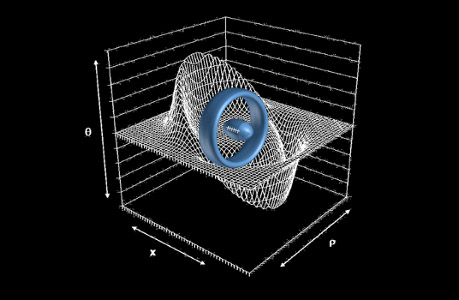
A space ship manipulates space both infront and behind
This video contains a facinating description by Harold White of the history and serch for warp speed, so sit back and strap in:
And finally, just because you were going to ask, this is a picture of Uhura:

Come join us on: